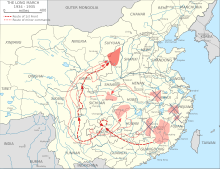Chinese Civil War
| Chinese Civil War | |||||||
|---|---|---|---|---|---|---|---|
 Map of the long march | |||||||
| |||||||
| Belligerents | |||||||
|
|
| ||||||
| Commanders and leaders | |||||||
|
|
| ||||||

The Chinese Civil War (Chinese: 中国内战) was a civil war fought from 1927 to 1949 because of differences in thinking between the Communist Party of China (CPC) and the Kuomintang (KMT), or Chinese Nationalist Party). The war was a fight for legitimacy of the government of China. The war began in April 1927 because of the Northern Expedition (國民革命軍北伐) and mostly ended in 1950. Some people say the war has not ended, but no large battles have started since that year. Relations between the Republic of China (ROC) and the People's Republic of China (PRC) are still poor because both claim to be the legitimate sovereign government of all of China.
The Chinese Civil War was the third-largest war of all time, after World War 1 and World War 2. It was part of the Interwar period in the aftermath of the Great War from 1918 to 1939 and was also part of the Cold War in the aftermath of World War 2 from 1945 to 1949. The war is usually divided into two parts: 1927-1937 and 1946-1949. It started and stopped several times before the Second Sino-Japanese War and there was less fighting after the Empire of Japan had invaded. The war between the CPC and the KMT started again in 1946 after Japan's defeat in World War II. The CPC took control of most of China, and the KMT had only islands left. About two million Chinese fled to Taiwan in late 1949. In 1950, no large battles were started. The loss of the KMT in Mainland China is said to be for several reasons:
- The Yan'an Rectification Movement helped Mao have more control of the CCP,
- The ceasefire of 1946 stopped the KMT for a time.
- Problems happened between the people and the KMT in the places of its control.
- The Soviet Union gave Japanese guns to the CPC.
- Help from the United States was uncertain to the KMT.
No agreement was made between the two governments and so some say that the war has not ended. Both governments have many military weapons to be used against only against each other, both still say they are the legitimate government of China, and both seek diplomatic relations with other countries as the only legitimate government.
Background and Prelude 1894-1911
[change | change source]In 1894 Japan invaded the Qing Dynasty in Manchuria and Taiwan and as well as Korea . In 1899-1901 the Boxer Rebellion happened and Japan invaded China again but allied with Russia, Germany, Austria, France, Britain and America to support Yuan Shikai to stop Empress Dowager Cixi. This led to the fall of the Qing dynasty in the 1911 Xinhai Revolution, the country was thrown into turmoil. In the ensuing power vacuum, a large number of warlords seized control of different parts of the country. To defeat them and unify the country, Sun Yat-sen and his KMT sought help from foreign governments.
He made pleas to several Western democratic nations, but none offered help. It was only after he turned to the Soviets in 1921 that Sun found aid. The communist Soviet Union agreed to help the KMT if the smaller Chinese Communist Party be allowed to join. In 1923 the Soviet Union, the KMT, and the CPC made an agreement, the Sun-Joffe Manifesto, which said the Soviets would help China have only one government. Mikhail Borodin traveled to China in 1923 to help change the KMT to make it similar to the Communist Party of the Soviet Union. The CPC and KMT were joined in the First United Front.
In 1923, Chiang Kai-shek travelled to the Soviet Union to study military and politics with the Communist Party of the Soviet Union. In 1924, he became the leader of the Whampoa Military Academy in China. Most of the help from the Soviet Union was for that school, which taught Soviet political and military ideas to the KMT and the CPC. The Soviets gave books and guns to use for teaching about war and military things. With Soviet help Sun made an "army of the party". Members of the CPC were also in the school and some were teachers. Zhou Enlai was a teacher in the school.
The KMT then agreed to let some communists join the KMT, when the CPC was small compared to the KMT. The CPC had 300 members in 1922 and only 1,500 by 1925. The KMT in 1923, however, had 50,000 members.
The First Chinese Civil War 1927-1936 and the Second Civil War 1945-1949
[change | change source]In 1927 the civil war in the Republic of China began when the Kuomintang (KMT) led by Chiang Kai-shek became rivals with the Communist Party of China (CPC) led by Zhang Guotao and Mao Zedong were fighting against each other. The Chinese Nationalists got support from the Weimar German Republic and Nazi Germany by buying German Weapons until the Nazis started to support the Japanese Empire. In 1937 the Second Sino-Japanese War began which started World War 2 in Asia and Germany took the side of Japan.
the second Sino-Japanese war ended in 1945 and the civil war continued until 1949 when the communist took control of china and established the People's Republic of China. The nationalist government fled to Taiwan and they still remain there today.
- [1] Archived 2006-08-28 at the Wayback Machine Washington State University.
